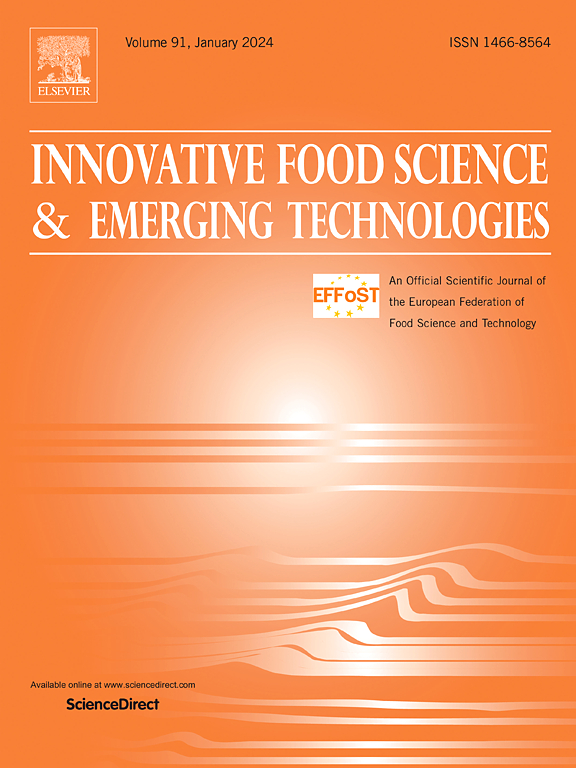微波加热是一种有前途的替代传统两段加热生产钠还原虾鱼糜的方法
IF 6.3
1区 农林科学
Q1 FOOD SCIENCE & TECHNOLOGY
Innovative Food Science & Emerging Technologies
Pub Date : 2025-03-28
DOI:10.1016/j.ifset.2025.104015
引用次数: 0
摘要
本研究旨在通过采用微波加热替代传统水浴加热来提高减钠虾鱼糜的产量,目的是创造一种既营养又美味的产品。与两段水浴加热法相比,微波加热法显著提高了虾鱼糜的凝胶强度和保水能力(P <;0.05)。蛋白质构象分析显示,由于微波加热,β-片结构和二硫键增加,这有助于形成均匀紧凑的结构,促进有效的水运动。此外,本研究还研究了味道特征和关键的味道化合物。结果表明,在7.5 W/g的微波加热条件下,鲜味核苷酸和甜味氨基酸的保留效果较好。这种保留有助于增强虾鱼味的鲜味和咸味。此外,还分析了味觉化合物与味觉强度之间的相关性和贡献程度。综上所述,微波处理是一种很有前途的物理改性技术,可以显著提高钠还原虾鱼糜的凝胶质量。本文章由计算机程序翻译,如有差异,请以英文原文为准。
Microwave heating as a promising alternative to traditional two-stage heating in the production of sodium-reduced shrimp surimi
This study aimed to enhance the production of sodium-reduced shrimp surimi by employing microwave heating as an alternative to conventional water bath heating, with the objective of creating a product that is both nutritious and palatable. Compared to the two-stage water bath heating method, microwave heating significantly enhanced the gel strength, and water retention capacity of shrimp surimi (P < 0.05). Protein conformation analysis revealed an increase in β-sheet structures and disulfide bonds due to microwave heating, which contributed to a homogeneous and compact structure that facilitates efficient water movement. In addition, this study examined the taste characteristics and key taste compounds. The results indicated that under microwave heating conditions of 7.5 W/g, a variety of taste components particularly umami nucleotides and sweet amino acids can be retained more effectively. This retention contributes to the enhancement of both umami and saltiness in shrimp surimi. Furthermore, an analysis was conducted on the correlation and degree of contribution between taste compounds and taste intensity. In conclusion, microwave treatment presents a promising physical modification technique for significantly improving the gel quality of sodium-reduced shrimp surimi.
求助全文
通过发布文献求助,成功后即可免费获取论文全文。
去求助
来源期刊
CiteScore
12.00
自引率
6.10%
发文量
259
审稿时长
25 days
期刊介绍:
Innovative Food Science and Emerging Technologies (IFSET) aims to provide the highest quality original contributions and few, mainly upon invitation, reviews on and highly innovative developments in food science and emerging food process technologies. The significance of the results either for the science community or for industrial R&D groups must be specified. Papers submitted must be of highest scientific quality and only those advancing current scientific knowledge and understanding or with technical relevance will be considered.

 求助内容:
求助内容: 应助结果提醒方式:
应助结果提醒方式:


